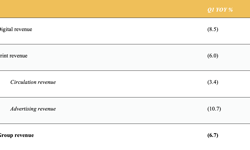"Why don’t you act on your readers’ wishes and put the crossword back so we can more conveniently fold the paper horizontally. If this doesn’t happen soon, I, for one, will be forced to switch to the Telegraph."
So there you have it. All those months of planning, dreaming up new typefaces, setting up focus groups and it comes down to this. They don’t like what’s happened to the crossword.
This comment on the latest incarnation of the Times, which underwent some ‘self-improvement’ in June, should serve as a sober warning to all publishers planning a redesign or a relaunch. Forget the readers at your peril.
New editor, new proprietor, new presses, there’s an ‘R’ in the month… whatever the reason a redesign is tackled, the most important people always seem to get forgotten.
I remember sitting proudly in the afterglow of one successful relaunch when a reader called to protest: "What have you done to my paper?"
And that is the essence of where the focus of any efforts at a revamp should start. Are the readers deserting you? If so, try to find out why and how a redesign might help staunch the flow.
Former Independent design director Michael Crozier (www.designunlimited-uk.com), who has redesigned and relaunched 50 newspapers around the world, says it is important to prepare the ground.
"Research local conditions and the local markets. In a modern world of market research, focus groups may be important if only to please the client. Do your homework," he says.
"Also, do not expect your employers to know anything about the finer points of newspaper design. Page designers are not far off the lowest of the low in many countries."
Design consultant Matthew Ball (www.matthewball.co.uk), who worked with the Morning Advertiser on their new look, says that it is important that every member of staff should understand what the new design is trying to do.
"There is no point in investing in a redesign for the title to fall back into old ways in a couple of issues. The new design should take into account the size of the team, the abilities of the staff and the production schedules."
"Redesigns should make the life easier for the team, so they can concentrate on the important stuff like ideas, headlines, pictures, captions and the story," says Ball.
So, what has everyone been up to?
The Tidy-Up
The latest tidy-up of the Sunday Times – not enough has happened to really call it a redesign – has strengthened what they do best. No outrage at moving the crossword (you never can find the crossword in the Sunday Times anyway), just a stronger branding of the discrete sections.
The section titles – Sport, Money etc – now leap out in white from a stylish colour, which is then repeated on the folio lines throughout the section. The boldness of the move makes it a success that readers should learn to appreciate.
This device neatly tackles one of the title’s inherent problems. With nine newsprint sections totalling more than 200 pages and three glossy magazines also weighing in at 200 pages-plus, it’s just too big.
Then there are the giant pages. With 4312.5 square centimetres to play with on a broadsheet spread – 40% more than in the Observer – the temptation is just to make everything bigger to compensate.
And, while some headlines do look too big and windy, the use of pictures is still a joy. Sport probably benefits most from the big, bold approach. Quality pictures are used with verve and courage making the most of the broad canvas. And then little things matter here too, with readable results, tables and stats panels.
The Overhaul
James Harding, six months in the hot-seat at the Times, went for some bold, dramatic changes as he piggybacked onto full-colour availability throughout to bring a new structure to his title.
Top of the changes was moving the leading articles, as the Times likes to call them, to page 2. "We have done so in the belief that a modern newspaper is about information and the ideas that make sense of it," said the leading article about the leading articles (keep up, please) in the relaunch edition.
Cue wailing and gnashing from readers and online show-offs, but what’s not to like? Page 2 is traditionally a tricky graveyard for contents, puffs, flannel panels etc so putting it to good use makes sound sense.
But the other design tricks bring long, wordy headlines, overblown pictures and a general feeling that this is a victory for style over substance. Unless a redesign is backed up by a thorough overhaul of the content, it can feel like a shuffling of the same poor hand.
The Big-into-Small
The regional press has been quietly going about its own tabloid conversion since the early 1990s, when I helped the then Thomson Regional Newspapers titles at Newcastle, Cardiff, Edinburgh and Aberdeen make the move from big, unwieldy broadsheets to zippy tabloids.
The Oxford Times lost its status as one of the last big, weekly broadsheets when it switched to tabloid in March. The all important property supplement – still one of the best reads in the regional press – stayed in the larger format to accommodate Knight Frank’s finest but the main paper (56 pages including sport), Weekend leisure pull-out (32 pages) and Motoring (16 pages) all down-sized.
"Our readership is not typical of a local weekly paper – it’s very much made up of people who read the quality nationals," explained editor Derek Holmes. "We’re not going down-market; we’re changing size, but the value and quality of what we do remains exactly the same."
The Press in York took the tabloid plunge in 2004 and decided to go for an "upmarket" redesign in May. Like many regional daily titles, it had already switched from morning publishing and dropped the ‘Evening’ from its title.
The resulting ‘compact’, complete with a redrawn masthead still featuring the famous York Minster, is pleasant enough in an unthreatening BBC Breakfast sort of way but struggles a bit to contain its brasher roots. Big, old-fashioned headlines dominate the smaller pages and the chunky sans typefaces do little to engender the more user-friendly and "upmarket shift" signalled by the editor.
Change of Image
Like the product of wacky professors in the Newspaper Lab, the once great Daily Mirror has popped up as Heat meets Weekly World News.
There are celebrity stories, wacky pictures, promos, true life tales and oh, the occasional news story too.
There are some bizarre design decisions: the re-emergence of italic type – well, not really italics, just a sloping version of the new sans face, Farao – an over-reliance on yellow throughout and over-fiddly graphics like the computer key bylines.
The makeover was masterminded by Spanish designer Cases Associats, which has history here, having previously redesigned the Independent. Determined to remove the traditional clutter of a British tabloid, they have come up with a hybrid Euro-style newspaper with all the excesses of the magazine industry. Let’s see how the readers vote…
Newspaper to Magazine
Step forward two of les grandes dames of publishing: the Morning Advertiser and Times Higher Education. The weekly (formerly daily) pub-trade title underwent a transformation from rather tired tabloid to a fresh and modern A4 magazine.
Tim Brooke-Webb, Morning Advertiser publisher, explained the change in size: "We have witnessed a general move away from broadsheets in favour of down-sizing – the Times was the first high-profile name to do just that back in 2003. Readers prefer A4, something our own extensive research shows – it’s more convenient."
They developed a fresh look, including new logo, fonts and colour palette. And they get round that familiar problem for trade mag editors – lack of pictures – by having a bold and flexible design that allows graphic alternatives to be used when good images aren’t available.
Designer Matthew Ball said that editor Andrew Pring had a good idea of what he wanted to do with his title, but was also interested in looking for new ideas. "MA wasn't ‘broken’ so we had to bring the readers along by balancing ‘old favourites’ with new editorial," said Ball.
Times Higher Education lost its ‘the’ and ‘supplement’ in the radical overhaul early this year and in one giant leap went from old-fashioned tabloid ‘trade paper’ to a quarto-sized magazine.
With its big front page image and natty teasers, it sits happily in the ‘business magazines’ section on the newsstand alongside the Economist, the Spectator and Newsweek. Editor Gerard Kelly said in the relaunched issue: "Magazine readership… is stable or increasing. That is one powerful and obvious reason why we have changed our format from a newspaper to a news magazine."
A further reason, he writes, for changing "is unabashedly cosmetic – magazines look more attractive … they are more manageable, durable and portable."
The What??!!
The Loughborough Echo went back to the future and revived the 117-year-old title’s original masthead. It plonked the Gothic masterpiece on top of what the editor calls a "bright, busy and modern look". Editorial director Tony Lennox was delighted with the new look: "It was a very fashionable design for the eighties, but it hasn’t aged well. It was the newspaper equivalent of flares, flowery shirt and a Kevin Keegan perm. No one’s going to miss it," he said.
| The InPublishing Guide to Getting it Right * Define the problem What is wrong with the design you have at the moment? Does it, simply, look dated and needs a ‘Spring clean’ or are there more structural problems that make the design difficult to adapt to new editorial ideas. * Find out what makes your title unique Figure out what is working and what isn’t working. What makes your title unique and differentiates it from your competitors? * Set up an inclusive working party Involve anybody and everybody in the redesign process. If you suddenly emerge from a darkened room shouting "Eureka! We have a new paper", you’ll find it hard to sustain the changes with both staff and readers. * Make it practical Come up with a plan that is straightforward to execute on a daily basis. Fine tuned dummies are all very well, but not if they include fiddly details that can’t be replicated in the heat of battle. * Explain what you’re doing First off, involve the staff who’ve got to make it work. Set up training and development sessions and take on board suggestions from the floor. Then, tell the readers what’s going on in a clear, concise way that justifies what you’ve done. Finally, does your design meet the four vital criteria? 1) Symbolism – like the Independent eagle. 2) Aesthetics – attractive typography. 3) Accessibility – is it easy to follow? 4) Is it, at the end of the day, functional – doing what it is supposed to do? Compiled with help from Mssrs Ball and Crozier. |










